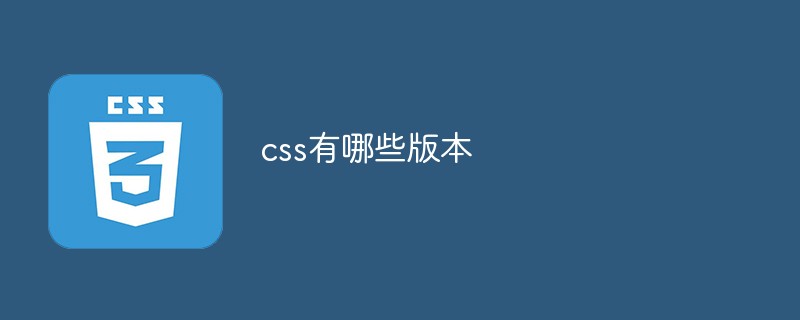What versions of css are there?
css is "cascading style sheet", its versions are: 1. CSS1.0, which is the first standard related to style; 2. CSS2.0, this version recommends the separation of content and performance effects Method; 3. CSS2.1, which is slightly modified based on CSS2.0; 4. CSS3, which is the third version of the CSS specification.

The operating environment of this tutorial: windows7 system, HTML5&&CSS3 version, Dell G3 computer.
CSS’s full English name is Cascading Style Sheet, and its Chinese translation is “Cascading Style Sheet”. CSS is mainly a style design language that enriches the content of HTML tags and separates the web page presentation style from the web page structure. You can use CSS to control the display style of the text content, image shape, layout and other appearance in the HTM page.
What is CSS
In the early 1990s, the HTML language was born, and various forms of style sheets also appeared. But as the functionality of HTM increases, foreign languages for defining styles become increasingly meaningless. In 1994, Hakun Li proposed the original proposal of CSS. Bert Bos was designing a browser called Argo at the time, and they decided to collaborate on the design of CSS. Since its development, there have been 4 versions of CSS. The specific introduction is as follows
1.CSS1.0
In December 1991, W3C released the first style-related standard CSS1.0. This version already includes related attributes of font, color and background, text, box, etc.
2.CSS2.0
In May 1985, CSS2.0 was officially launched. What this version recommends is the separation of content and presentation effects, and the use of style sheet structures.
3.CSS2.1
In February 2004, CSS2.1 was officially launched. It is slightly modified based on CSS2.0 and deletes many attributes that are not supported by browsers.
4.CSS3
As early as 2001, W3C began preparing to develop the third edition of the CSS specification. Although the complete, standardized and authoritative CSS3 standard has not yet been finalized, major browsers have begun to support most of its features.
Recommended: "css video tutorial"
The above is the detailed content of What versions of css are there?. For more information, please follow other related articles on the PHP Chinese website!

Hot AI Tools

Undresser.AI Undress
AI-powered app for creating realistic nude photos

AI Clothes Remover
Online AI tool for removing clothes from photos.

Undress AI Tool
Undress images for free

Clothoff.io
AI clothes remover

Video Face Swap
Swap faces in any video effortlessly with our completely free AI face swap tool!

Hot Article

Hot Tools

Notepad++7.3.1
Easy-to-use and free code editor

SublimeText3 Chinese version
Chinese version, very easy to use

Zend Studio 13.0.1
Powerful PHP integrated development environment

Dreamweaver CS6
Visual web development tools

SublimeText3 Mac version
God-level code editing software (SublimeText3)

Hot Topics
 1386
1386
 52
52
 How to use bootstrap in vue
Apr 07, 2025 pm 11:33 PM
How to use bootstrap in vue
Apr 07, 2025 pm 11:33 PM
Using Bootstrap in Vue.js is divided into five steps: Install Bootstrap. Import Bootstrap in main.js. Use the Bootstrap component directly in the template. Optional: Custom style. Optional: Use plug-ins.
 The Roles of HTML, CSS, and JavaScript: Core Responsibilities
Apr 08, 2025 pm 07:05 PM
The Roles of HTML, CSS, and JavaScript: Core Responsibilities
Apr 08, 2025 pm 07:05 PM
HTML defines the web structure, CSS is responsible for style and layout, and JavaScript gives dynamic interaction. The three perform their duties in web development and jointly build a colorful website.
 How to write split lines on bootstrap
Apr 07, 2025 pm 03:12 PM
How to write split lines on bootstrap
Apr 07, 2025 pm 03:12 PM
There are two ways to create a Bootstrap split line: using the tag, which creates a horizontal split line. Use the CSS border property to create custom style split lines.
 Understanding HTML, CSS, and JavaScript: A Beginner's Guide
Apr 12, 2025 am 12:02 AM
Understanding HTML, CSS, and JavaScript: A Beginner's Guide
Apr 12, 2025 am 12:02 AM
WebdevelopmentreliesonHTML,CSS,andJavaScript:1)HTMLstructurescontent,2)CSSstylesit,and3)JavaScriptaddsinteractivity,formingthebasisofmodernwebexperiences.
 How to insert pictures on bootstrap
Apr 07, 2025 pm 03:30 PM
How to insert pictures on bootstrap
Apr 07, 2025 pm 03:30 PM
There are several ways to insert images in Bootstrap: insert images directly, using the HTML img tag. With the Bootstrap image component, you can provide responsive images and more styles. Set the image size, use the img-fluid class to make the image adaptable. Set the border, using the img-bordered class. Set the rounded corners and use the img-rounded class. Set the shadow, use the shadow class. Resize and position the image, using CSS style. Using the background image, use the background-image CSS property.
 How to set up the framework for bootstrap
Apr 07, 2025 pm 03:27 PM
How to set up the framework for bootstrap
Apr 07, 2025 pm 03:27 PM
To set up the Bootstrap framework, you need to follow these steps: 1. Reference the Bootstrap file via CDN; 2. Download and host the file on your own server; 3. Include the Bootstrap file in HTML; 4. Compile Sass/Less as needed; 5. Import a custom file (optional). Once setup is complete, you can use Bootstrap's grid systems, components, and styles to create responsive websites and applications.
 How to resize bootstrap
Apr 07, 2025 pm 03:18 PM
How to resize bootstrap
Apr 07, 2025 pm 03:18 PM
To adjust the size of elements in Bootstrap, you can use the dimension class, which includes: adjusting width: .col-, .w-, .mw-adjust height: .h-, .min-h-, .max-h-
 How to use bootstrap button
Apr 07, 2025 pm 03:09 PM
How to use bootstrap button
Apr 07, 2025 pm 03:09 PM
How to use the Bootstrap button? Introduce Bootstrap CSS to create button elements and add Bootstrap button class to add button text




